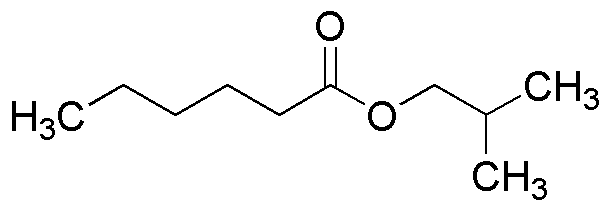Isobutyl hexanoate is widely utilized in research focused on:
- Flavoring and Fragrance Industry: This compound is commonly used as a flavoring agent in food products and beverages, providing a fruity aroma that enhances sensory experiences.
- Cosmetics and Personal Care: It serves as an ingredient in perfumes and lotions, contributing to pleasant scents and improving product texture, making it popular in the beauty industry.
- Solvent Applications: Isobutyl hexanoate acts as a solvent in various industrial processes, aiding in the formulation of paints and coatings, which require effective solubilization of pigments.
- Pharmaceuticals: In the pharmaceutical sector, it is utilized as an excipient, helping to improve the stability and delivery of active ingredients in medications.
- Agricultural Products: This chemical is also found in some agricultural formulations, enhancing the effectiveness of pesticides and herbicides by improving their spreadability and adhesion on plant surfaces.
General Information
Properties
Safety and Regulations
Applications
Isobutyl hexanoate is widely utilized in research focused on:
- Flavoring and Fragrance Industry: This compound is commonly used as a flavoring agent in food products and beverages, providing a fruity aroma that enhances sensory experiences.
- Cosmetics and Personal Care: It serves as an ingredient in perfumes and lotions, contributing to pleasant scents and improving product texture, making it popular in the beauty industry.
- Solvent Applications: Isobutyl hexanoate acts as a solvent in various industrial processes, aiding in the formulation of paints and coatings, which require effective solubilization of pigments.
- Pharmaceuticals: In the pharmaceutical sector, it is utilized as an excipient, helping to improve the stability and delivery of active ingredients in medications.
- Agricultural Products: This chemical is also found in some agricultural formulations, enhancing the effectiveness of pesticides and herbicides by improving their spreadability and adhesion on plant surfaces.
Documents
Safety Data Sheets (SDS)
The SDS provides comprehensive safety information on handling, storage, and disposal of the product.
Product Specification (PS)
The PS provides a comprehensive breakdown of the product’s properties, including chemical composition, physical state, purity, and storage requirements. It also details acceptable quality ranges and the product's intended applications.
Certificates of Analysis (COA)
Search for Certificates of Analysis (COA) by entering the products Lot Number. Lot and Batch Numbers can be found on a product’s label following the words ‘Lot’ or ‘Batch’.
*Catalog Number
*Lot Number
Certificates Of Origin (COO)
This COO confirms the country where the product was manufactured, and also details the materials and components used in it and whether it is derived from natural, synthetic, or other specific sources. This certificate may be required for customs, trade, and regulatory compliance.
*Catalog Number
*Lot Number
Safety Data Sheets (SDS)
The SDS provides comprehensive safety information on handling, storage, and disposal of the product.
DownloadProduct Specification (PS)
The PS provides a comprehensive breakdown of the product’s properties, including chemical composition, physical state, purity, and storage requirements. It also details acceptable quality ranges and the product's intended applications.
DownloadCertificates of Analysis (COA)
Search for Certificates of Analysis (COA) by entering the products Lot Number. Lot and Batch Numbers can be found on a product’s label following the words ‘Lot’ or ‘Batch’.
*Catalog Number
*Lot Number
Certificates Of Origin (COO)
This COO confirms the country where the product was manufactured, and also details the materials and components used in it and whether it is derived from natural, synthetic, or other specific sources. This certificate may be required for customs, trade, and regulatory compliance.

